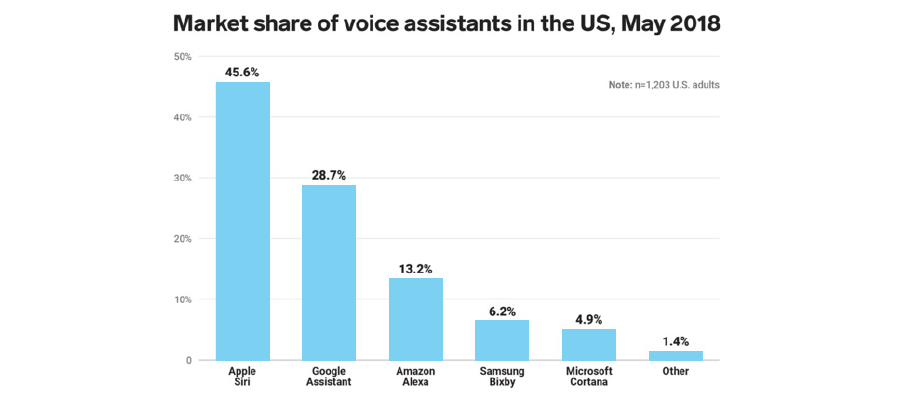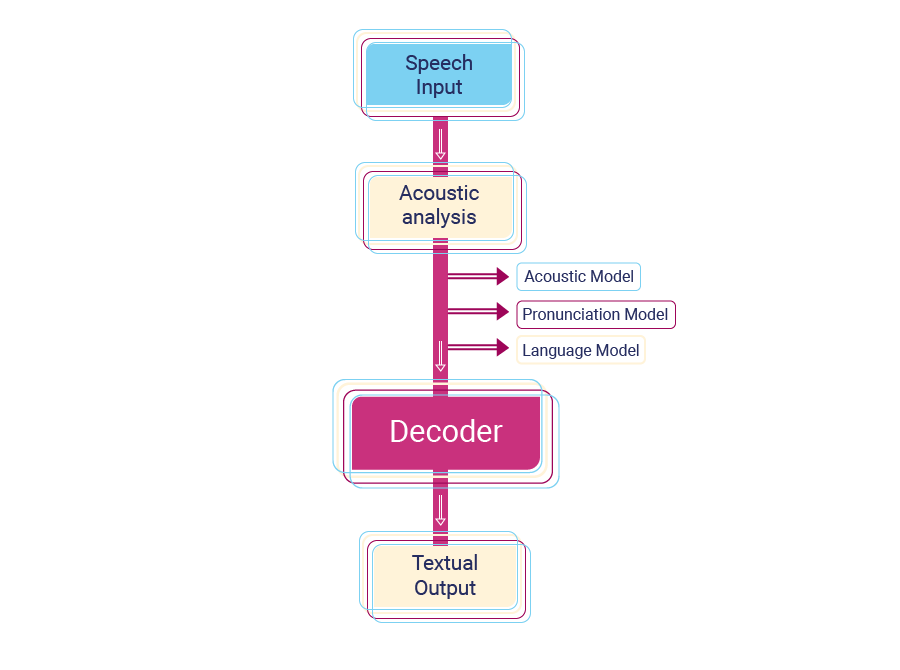Introduction
The rapid evolution of AI and machine learning made possible the development of voice recognition technology, which is how actively penetrating every area of our lives. And there’s nothing to wonder about: for such social-dependent creatures as humans, speaking is a lot more natural activity than writing or, of course, typing. An average human can type about 40 words in one minute, but pronounce 150. This contrast, alongside with many other benefits we’re discussing below, vividly demonstrates why voice technology should be taken seriously by not only IT giants and fans of smart homes, but every business owner out there.
What is a Voice Assistant?
Voice assistant (might be also called digital, virtual or AI assistant) is a task-oriented programming application that recognizes human speech and carries out commands pronounced by a user. It is powered by AI and bases its performance on cloud storage with millions of words and phrases in it. Unlike the very first voice recognition devices that scientists were working on in the 1940-50s, modern digital assistants aren’t restricted by a certain language pattern or vocabulary. As in 2018, there are two types of voice assistant software:
- Consumer-facing voice assistants for homes;
- Chatbots and virtual mobile assistants for a workplace.
The first type belongs to home automation (also called domotics or smart houses), a system that allows controlling appliance, lighting, electricity, gadgets, and other things filling in our houses. Home automation requires an internet connection and is a part of the Internet of Things (IoT). The second type, voice assistants for a workplace, can be used out of touch with building automation, as a standalone application incorporated in the professional routine of a team.
AI Assistants in Numbers
 |
of all internet searches will be conducted by voice by 2020 |
 |
of organizations have already implemented AI chatbots in their IT departments |
 |
of companies adopting voice assistants use them specifically for voice-to-text dictation to replace manual typing |
 |
of organizations enjoy the way chatbots simplify collaboration amongst teams |
 |
of enterprises use AI assistants for employee calendar management |

Top-three voice-driven software giants include Siri developed by Apple Inc., which powers Apple devices exclusively, Google Assistant from Google Inc. developed for Android OS, and Amazon Alexa, with a corresponding app for both iOS and Android. Of course, there a lot of smaller, yet still interesting digital assistant applications on the market, so check this link to find out our Top 10 Best virtual assistant apps.
How Speech Recognition Works

Voice assistant applications work based on Automatic Speech Recognition (ASR) system. ASR systems record the speech and then break it down into phonemes, which are later get processed into text. A phoneme (not words of syllables) is a basic unit of measurement for human speech recognition. Phoneme recognition delivers better results than the process of word decoding, as the last one tends to analyze word as a standalone unit ignoring the context limits.
No matter what kind of speech recognition software you may use, all the magic happens in its ASR. If you have ever wondered how to create a virtual assistant software, the foremost thing to do would be to get familiar with how ASR works. In a nutshell, the process starts with the device gathering audio with the microphone. Recorded speech waveforms get straight to acoustic analysis, which is performed on three different levels:
- acoustic modeling, which represents the which phonemes were pronounced and what are the words these phonemes complete;
- pronunciation modeling, that analyzes the way phonemes are pronounced, is there any accent or other peculiarities of the vocal apparatus to capture the phonetic variability of speech;
- language modeling, which is aimed at finding contextual probabilities depending on what phonemes were captured.
All the data get processed by AI without human interaction. The low error rate became that low due to improvements enforced by machine learning. The speech waveforms data is then transmitted to the decoder, where it finally transforms into text for further use like command or dictation.

Artificial intelligence gives modern voice assistant apps the freedom of not relying on a limited vocabulary, but use cloud storage with millions of words and phrases instead. In its turn, machine learning makes applications listen to the whole speech, not every word separately. That way, voice apps analyze context and probabilities to determine what are you trying to say. For example, Google uses a neural network with digital neurons similar to ones in human brain cells. Basically, this artificial neural network simulates the mental activity of our brains and mimics the processes that start when we hear the continuous stream of sounds. Regardless of the differences in architecture, all the most spread voice assistants like Google Assistant, Cortana, and Siri are powered by a deep neural network based engine at the backend.
Practical Applicability of Digital Assistants
Smart businesses never pause the search for better user experience for their clients. Voice recognition technology is all about getting more out of the devices users already own. Sending voice commands creates an atmosphere of familiarity and closer communication between users and their gadgets. With speech recognition technology, people remain connected to their devices although physically contacting them less, which brings extra advantages for people at the busy office setting. Development of neural networks and natural language processing altogether work towards making voice control a new standard for numerous products and actions people use/perform daily. Amazon Alexa Everywhere strategy started a new trend of companies releasing service device development kits for voice assistant app integrations. Manufacturers of home appliances like LG, Whirlpool, and Phillips already started releasing items that support Alexa, and consumer reaction quickly drew entrepreneurs’ attention to voice assistant apps. 72% of digital assistant owners admit that their devices quickly became an essential part of their daily routines and they wouldn’t want to give the use of voice control up due to the habit formed and ultimate ease of use. So, what are the actual duties and tasks can an AI assistant app perform for you? And how many of them would be useful at, let’s say, an office setting or a warehouse? Here are just a few of the actions voice-controlled devices can perform for you:
- send updates on topics of your interest without you searching for them (e.g., new laws & regulations implemented by the government if applies to your business);
- report the weather;
- add events and meetings to the calendar of a team or each member separately;
- set alarms and reminders so that everything happens in accordance with the schedule;
- answer general question with voice (instead of opening the link for you to search for an answer);
- create and fill in to-do lists;
- perform real-time translation;
- instantly update you on traffic on your route (especially useful for logistic operations);
- track the inventory in stock and automatically fill in shopping lists with items going to be out;
- control other devices from lighting to PCs;
- read emails and other documents out loud instead of you reading them;
- record the dictation speech and convert it into a text instead of you typing manually;
- find local businesses and contractors for your current needs.
Summary
Despite the debate about the potential of voice assistants is still ongoing, the way users feel about voice-driven software proves that this technology is here to stay. Market giants have already started exploring the benefits of voice control setting up a trend for smaller businesses out there. This does not mean you have to rush into integrating a voice assistant into your business right away. We recommend you start following up the experience of others and correlate it with your own business objectives. Chances are good the products or services you distribute would also benefit from an incorporated digital assistant, if it would be backed with thorough business planning and high-quality development. If you have any questions about how make a virtual assistant app, drop us a line to get a consultation.



 (5 votes, average: 4.60 out of 5)
(5 votes, average: 4.60 out of 5)